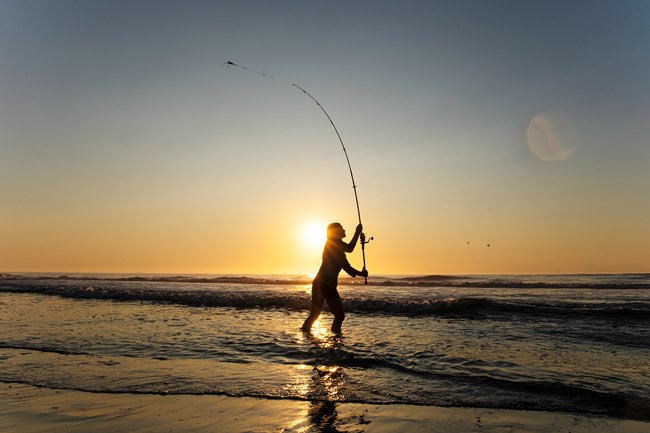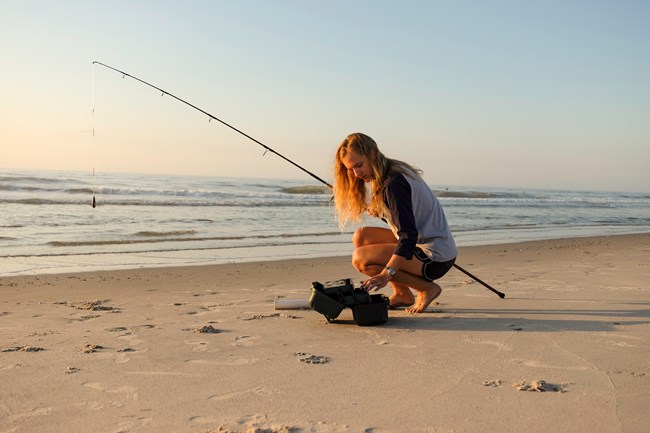
NPS Photo Regulations and General Information1. A saltwater license is required and state regulations on size, seasons, and limits are enforced. For current size limits, stop in at the Visitor Centers or Contact Ranger Station. For more information on licenses please visit our permits and reservations page. Please respect this natural resource and TAKE ONLY THE FISH THAT YOU PLAN TO EAT. Return all other fish carefully to the water.2. Fishing is not permitted within the boundaries of the lifeguard protected beaches. 3.In Virginia, open fires on the beach are permitted at designated sites by permit ONLY. In Maryland, beach fires are permitted for groups of 25 people or less on the beach between the high and low tide lines (not on the high beach). Fires must be completely extinguished with water and all debris removed from the beach. Groups larger than 25 people need to obtain a Special Use Permit. 4. Deposit all trash in containers or carry it out with you. 5. Camping or overnight sleeping is permitted only in designated camping areas in Maryland. Overnight sleeping is not permitted in Virginia. 6. The Virginia entrance is open from 5 a.m. to 10 p.m., May through September; 6 a.m. to 8 p.m., April and October, and from 6 a.m. to 6 p.m. , November through March. After hours fishing passes may be obtained at the Herbert H. Bateman Educational and Administrative Center. After hours fishing passes are not required in Maryland. 7. Over Sand Vehicles are allowed in designated areas along the seashore by permit ONLY. Permits must be purchased online at recreation.gov. . 8. The signed and fenced areas on the Toms Cove Hook are reserved for nesting birds. Some of these species are protected by the Endangered Species Act. Be aware, there are posted bird nesting areas on other parts of the island. DO NOT ENTER THESE AREAS. Safety Tips1. Use caution when casting. Keep a safe distance from other anglers. Look around before each cast - swimmers frequently drift into fishing areas. Fish hooks can inflict painful wounds.2. Leave the beach during lightning storms! Do not seek shelter under a beach umbrella. 3. Avoid prolonged exposure to the sun to prevent suntroke, sunburn and dehydration. Wear a shirt, hat and sunglasses. Sunscreen and drinking water are recommended! 4. First aid and emergency assistance are available at the Contact Ranger Station and Barrier Island Visitor Center in Maryland, both Visitor Centers in Virginia and at lifeguard stands. 
NPS Photo EquipmentThe challenge of surf fishing has lured anglers to Assateague's beaches for many generations. Whether just casually "wetting a line" while relaxing in the sun or pure, serious fishing addiction draws you to the surf line, the hope of "catching" cannot be denied! The surf caster's choice of equipment is a matter of personal preference.The heavy duty 13-foot surf rod and casting or spinning reel provides maximumm casting distance and is needed for larger surf species. However, a smaller surf rod (10-12 foot) with a spinning reel can be used successfully. In gentle surf, even a 6 to 8 foot casting rod and spinning reel can provide excellent sport. Keep in mind, heavy action fresh water gear can be used under some conditions. Surf conditions will often dictate the type of tackle necessary for successful fishing. The rod used must be able to cast a sinker of sufficient weight to hold bottom. When oceans currents are strong and wave action is heavy, a very heavy sinker is needed. Pyramid sinkers or no-roll sinkers are best for holding bottom in the surf. Weights range from two to six ounces. Three or four ounce sinkers are suitable for most surf conditions. Line weight depends on wind and surf conditions, type of bait and size of fish. 17-20 lb test line will be satisfactory in most situations. Salt water and sand are surf fishing equipment's worst enemy! A sand spike will keep a rod and reel out of the sand. All salt water gear should be rinsed with fresh water after use. After rinsing, an application of light-weight lubrication on the moving reel parts is recommended. Recommended Bait and Gear
For more information, a fish identification guide and size limits, stop by a Visitor Center or the Contact Ranger Station.
|
Last updated: November 16, 2025
